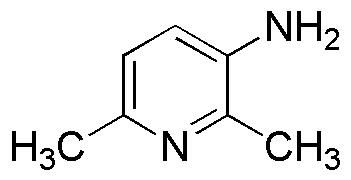3-Amino-2,6-lutidine is widely utilized in research focused on:
- Pharmaceutical Development: This compound serves as an intermediate in the synthesis of various pharmaceuticals, particularly in the development of drugs targeting neurological disorders.
- Catalysis: It acts as a ligand in catalysis, enhancing reaction rates and selectivity in organic synthesis, which is crucial for the production of fine chemicals.
- Agrochemicals: Used in the formulation of agrochemicals, it contributes to the development of more effective pesticides and herbicides, improving agricultural productivity.
- Material Science: Its properties make it suitable for creating specialized polymers and coatings, which are essential in industries such as automotive and electronics.
- Analytical Chemistry: Employed as a reagent in various analytical techniques, it aids in the detection and quantification of other compounds, enhancing laboratory efficiency.
Información general
Propiedades
Seguridad y normativas
Aplicaciones
3-Amino-2,6-lutidine is widely utilized in research focused on:
- Pharmaceutical Development: This compound serves as an intermediate in the synthesis of various pharmaceuticals, particularly in the development of drugs targeting neurological disorders.
- Catalysis: It acts as a ligand in catalysis, enhancing reaction rates and selectivity in organic synthesis, which is crucial for the production of fine chemicals.
- Agrochemicals: Used in the formulation of agrochemicals, it contributes to the development of more effective pesticides and herbicides, improving agricultural productivity.
- Material Science: Its properties make it suitable for creating specialized polymers and coatings, which are essential in industries such as automotive and electronics.
- Analytical Chemistry: Employed as a reagent in various analytical techniques, it aids in the detection and quantification of other compounds, enhancing laboratory efficiency.
Documentos
Hojas de datos de seguridad (HDS)
La SDS proporciona información de seguridad completa sobre la manipulación, el almacenamiento y la eliminación del producto.
Especificación del producto (PS)
La PS proporciona un desglose completo de las propiedades del producto, incluida la composición química, el estado físico, la pureza y los requisitos de almacenamiento. También detalla los rangos de calidad aceptables y las aplicaciones previstas del producto.
Certificados de análisis (COA)
Busque certificados de análisis (COA) ingresando el número de lote del producto. Los números de lote y de partida se pueden encontrar en la etiqueta de un producto después de las palabras "Lote" o "Lote".
Número de catálogo
Número de lote/lote
Certificados de origen (COO)
Este certificado de origen confirma el país en el que se fabricó el producto y también detalla los materiales y componentes utilizados en él y si se deriva de fuentes naturales, sintéticas u otras fuentes específicas. Este certificado puede ser necesario para cumplir con las normativas aduaneras, comerciales y regulatorias.
Número de catálogo
Número de lote/lote
Hojas de datos de seguridad (HDS)
La SDS proporciona información de seguridad completa sobre la manipulación, el almacenamiento y la eliminación del producto.
DownloadEspecificación del producto (PS)
La PS proporciona un desglose completo de las propiedades del producto, incluida la composición química, el estado físico, la pureza y los requisitos de almacenamiento. También detalla los rangos de calidad aceptables y las aplicaciones previstas del producto.
DownloadCertificados de análisis (COA)
Busque certificados de análisis (COA) ingresando el número de lote del producto. Los números de lote y de partida se pueden encontrar en la etiqueta de un producto después de las palabras "Lote" o "Lote".
Número de catálogo
Número de lote/lote
Certificados de origen (COO)
Este certificado de origen confirma el país en el que se fabricó el producto y también detalla los materiales y componentes utilizados en él y si se deriva de fuentes naturales, sintéticas u otras fuentes específicas. Este certificado puede ser necesario para cumplir con las normativas aduaneras, comerciales y regulatorias.


